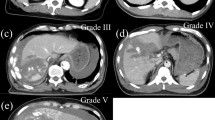Abstract
Background
The liver is the most frequently injured solid intra-abdominal organ. The major cause of early death following severe liver trauma is exsanguination. Although perihepatic packing improves survival in severe liver trauma, this leaves parenchymal damage untreated, often resulting in post-traumatic biliary leakage and a subsequent rise in morbidity. The aim of this study was to analyze the incidence and treatment of biliary leakage following the operative management of liver trauma.
Methods
Patients presenting between 2000 and 2009 to Erasmus University Medical Centre with traumatic liver injury were identified. Data from 125 patients were collected and analyzed. Sixty-eight (54 %) patients required operation. All consecutive patients with post-operative biliary complications were analyzed. Post-operative biliary complications were defined as biloma, biliary fistula, and bilhemia.
Results
Ten (15 %) patients were diagnosed with post-operative biliary leakage following liver injury. Three patients with a biloma were treated with percutaneous drainage, without further intervention. Seven patients with significant biliary leakage were managed by endoscopic stenting of the common bile duct to decompress the internal biliary pressure. One patient had a relaparotomy and right hemihepatectomy to control biliary leakage and injury of the right hepatic duct.
Conclusion
Biliary complications continue to occur frequently following damage control surgery for liver trauma. The majority of biliary complications can be managed without an operation. Endoscopic retrograde cholangiopancreatography (ERCP) and internal stenting represent a safe strategy to manage post-operative biliary leakage and bilhemia in patients following liver trauma. Minor biliary leakage should be managed by percutaneous drainage alone.


Similar content being viewed by others
References
Feliciano DV. Surgery for liver trauma. Surg Clin North Am. 1989;69:273–84.
Meredith JW, Ditesheim JA, Stonehouse S, Wolfman N. Computed tomography and diagnostic peritoneal lavage. Complementary roles in blunt trauma. Am Surg. 1992;58:44–8.
Beal SL. Fatal hepatic hemorrhage: an unresolved problem in the management of complex liver injuries. J Trauma. 1990;30:163–9.
Feliciano DV, Mattox KL, Burch JM, Bitondo CG, Jordan GL Jr. Packing for control of hepatic hemorrhage: 58 consecutive patients. J Trauma. 1986;26:738–43.
Krige JE, Bornman PC, Terblanche J. Therapeutic perihepatic packing in complex liver trauma. Br J Surg. 1992;79:43–6.
Caruso DM, Battistella FD, Owings JT, Lee SL, Samaco RC. Perihepatic packing of major liver injuries: complications and mortality. Arch Surg. 1999;134:958–62.
Nicol AJ, Hommes M, Primrose R, Navsaria PH, Krige JEJ. Packing for control of hemorrhage in major liver trauma. World J Surg. 2007;31:569–74.
Hollands MJ, Little JM. Post-traumatic bile fistulae. J Trauma. 1991;31:117–20.
Howdieshell TR, Purvis J, Bates WB, Teeslink CR. Biloma and biliary fistula following hepatorraphy for liver trauma: incidence, natural history, and management. Am Surg. 1995;61:165–8.
Asensio JA, Demetriades D, Chahwan S, et al. Approach to the management of complex hepatic injuries. J Trauma. 2000;48:66–9.
Clemens M, Wittrin G. Bilhämie und Hämobilie nach Reitunfall. Hamburg: Tagung Nordwestdeutscher Chirurgen; 1975. Vortrag 166.
Hommes M, Kazemier G, van Dijk LC, et al. Complex liver trauma with bilhemia treated with perihepatic packing and endovascular stent in the vena cava. J Trauma. 2009;67(2):E51–3.
Kozar RA, Moore FA, Cothren CC, et al. Risk factors for hepatic morbidity following nonoperative management: multicenter study. Arch Surg. 2006;141(5):451–8; discussion 458–9.
Moore EE, Feliciano DV, Mattox KL, editors. Trauma. 5th en. New York: McGraw-Hill; 2004. Chapter 31: liver and biliary trauma. p. 653.
Goldman R, Zilkoski M, Mullins R, Mayberry J, Deveney C, Trunkey D. Delayed celiotomy for the treatment of bile leak, compartment syndrome, and other hazards of nonoperative management of blunt liver injury. Am J Surg. 2003;185(5):492–7.
Carrillo EH, Reed DN Jr, Gordon L, Spain DA, Richardson JD. Delayed laparoscopy facilitates the management of biliary peritonitis in patients with complex liver injuries. Surg Endosc. 2001;15(3):319–22.
Lubezky N, Konikoff FM, Rosin D, Carmon E, Kluger Y, Ben-Haim M. Endoscopic sphincterotomy and temporary internal stenting for bile leaks following complex hepatic trauma. Br J Surg. 2006;93:78–81.
Bridges A, Wilcox CM, Varadarajulu S. Endoscopic management of traumatic bile leaks. Gastrointest Endosc. 2007;65(7):1081–5.
Thomson BNJ, Nardino B, Gumm K, et al. Management of blunt and penetrating biliary tract trauma. J Trauma. 2012;72(6):1620–5.
American College of Surgeons Committee on Trauma. Advanced Trauma Life Support® (ATLS) Student Course Manual. 7th ed.
Ku J, Brasel KJ, Baker CC, Rutherford EJ. Triangle of death: hypothermia, acidosis, and coagulopathy. New Horiz. 1999;7:61–72.
American College of Surgeons Committee on Trauma. Advanced Trauma Operative Management: Surgical Strategies for Penetrating Trauma. 2nd ed. 2010.
Parks RW, Chrysos E, Diamond T. Management of liver trauma. Br J Surg. 1999;86(9):1121–35.
Couinaud C. Lobes et segments hepatiques: notes sur l’architecture anatomique et chirurgicale du foie. Press Med. 1954;62:709–12.
Croce MA, Fabian TC, Kudsk KA, et al. AAST organ injury scale: correlation of CT-graded liver injuries and operative findings. J Trauma. 1991;31(6):806–12.
Cogbill TH, Moore EE, Jurkovich GJ, Feliciano DV, Morris JA, Mucha P. Severe hepatic trauma: a multi-center experience with 1,335 liver injuries. J Trauma. 1988;28:1433–8.
Pringle JH. V. Notes on the arrest of hepatic hemorrhage due to trauma. Ann Surg. 1908;48(4):541–9.
Acknowledgments
Trauma Center Southwest Netherlands, The Netherlands, J. van der Stok and S.F. Kodde in providing data from the trauma database.
Conflict of interest
All authors declare not to have a conflict of interest.
Author information
Authors and Affiliations
Corresponding author
Additional information
All authors contributed equally to the study.
Rights and permissions
About this article
Cite this article
Hommes, M., Kazemier, G., Schep, N.W.L. et al. Management of biliary complications following damage control surgery for liver trauma. Eur J Trauma Emerg Surg 39, 511–516 (2013). https://doi.org/10.1007/s00068-013-0304-4
Received:
Accepted:
Published:
Issue Date:
DOI: https://doi.org/10.1007/s00068-013-0304-4




